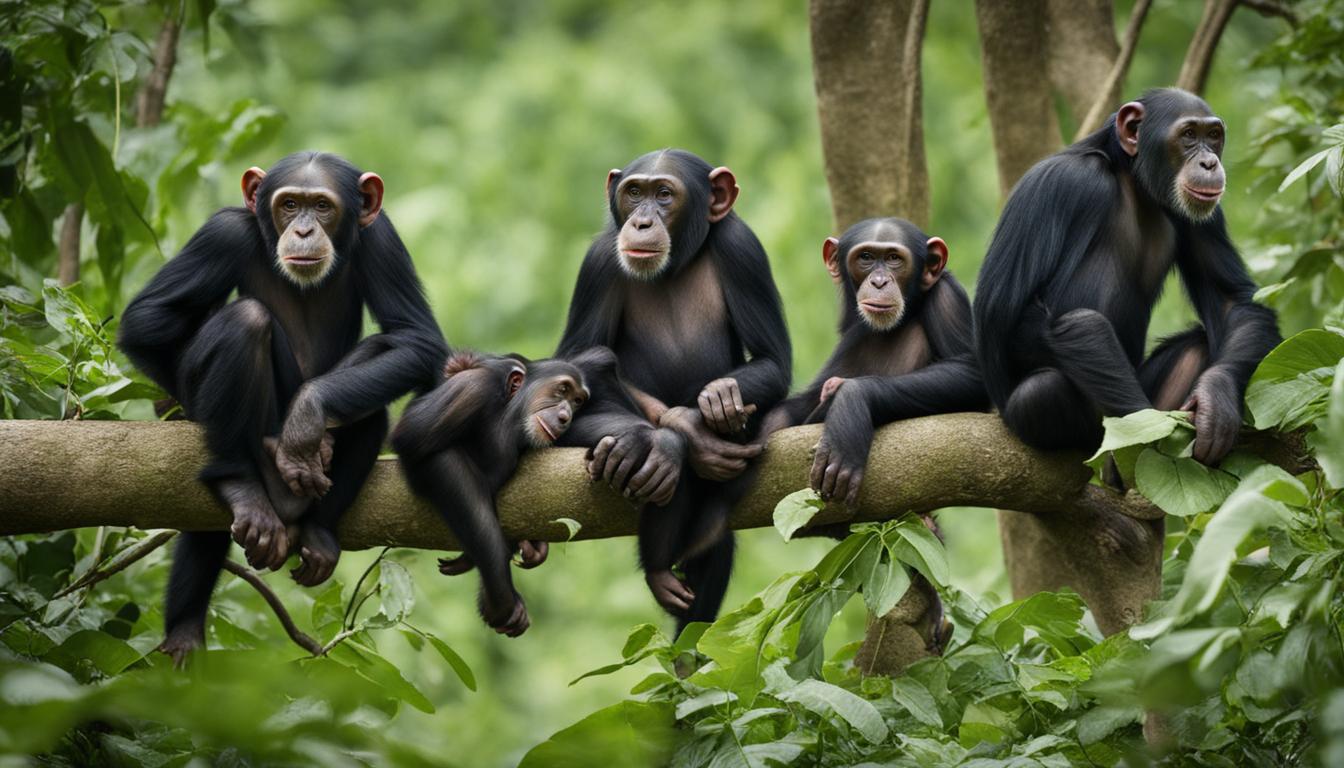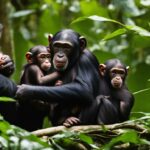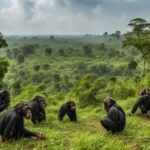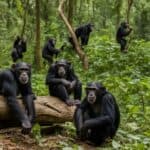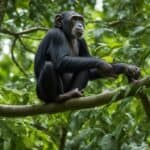Chimpanzees, our close relatives, play a vital role in maintaining the diversity of Central Africa’s forests. All four chimpanzee subspecies are currently endangered due to habitat loss, disease, and hunting for bushmeat. The main challenges to chimpanzee conservation are their slow reproductive rate and the long time it takes to replace breeding individuals. Conservation efforts aim to protect chimpanzees by working with NGOs, national governments, and local communities. Measures include developing action plans, improving wildlife protection, and implementing environmental education programs. Ebola outbreaks also pose a significant threat, with a mortality rate of around 95%. Monitoring and rapid processing of samples are being done by organizations like WCS to combat the spread of Ebola among chimpanzees.
Importance of Chimpanzee Conservation
Chimpanzees are magnificent creatures that hold significant importance in the ecosystem. They play a crucial role in seed dispersal, contributing to the growth and restoration of forests in Central Africa. Their dung acts as a carrier of whole seeds, allowing for the dispersal of various plant species across different areas. This process not only aids in maintaining the biodiversity of the region but also supports the regeneration of clear forest areas. By conserving chimpanzees, we are actively contributing to the preservation and restoration of vital forest ecosystems.
In addition to their role in seed dispersal, chimpanzees possess a high level of intelligence and exhibit complex social structures. Their ability to make and use tools is a testament to their cognitive capabilities, challenging the notion that tool usage is exclusive to humans. These characteristics make chimpanzees a unique and valuable species, deserving of our efforts to protect and conserve them.
“Chimpanzees are the closest living relatives to humans, sharing approximately 98% of our DNA. As such, they provide us with valuable insights into our own evolutionary history and behavior.”
Conservation initiatives for chimpanzees aim to safeguard their habitats, prevent poaching for bushmeat and the pet trade, and raise awareness about the importance of their existence in the ecosystem. By prioritizing their conservation, we are not only preserving the biodiversity of our planet but also protecting a species that shares a significant genetic connection with humankind. By acting now, we can ensure the survival of chimpanzees and secure a future where these incredible creatures continue to thrive alongside us.
The Role of Chimpanzees in Maintaining Forest Ecosystems
Chimpanzees’ foraging behavior and seed dispersal activities have a profound impact on the structure and composition of forest ecosystems. As they move through the forest, searching for food, they consume fruits and disperse the undigested seeds through their excrement. These seeds can then germinate and grow, contributing to the overall growth and diversity of the forest vegetation. Without the active involvement of chimpanzees in dispersing seeds, many plant species would struggle to reproduce and spread, leading to a decline in forest health and diversity.
| Impact of Chimpanzee Seed Dispersal | Benefits |
|---|---|
| Enhanced Forest Regeneration | Chimpanzee-dispersed seeds accelerate the regeneration of forest areas, helping to restore vegetation and increase the overall resilience of the ecosystem. |
| Diversity of Plant Species | Chimpanzees disperse a wide range of plant species, contributing to the biodiversity of forests and promoting a healthier ecosystem. |
| Forest Connectivity | Chimpanzees play a key role in connecting fragmented forest patches by dispersing seeds, facilitating gene flow and maintaining genetic diversity among plant populations. |
These findings highlight the vital role of chimpanzees in supporting the health and resilience of forest ecosystems. By protecting chimpanzees and their habitats, we can ensure the preservation of these delicate ecosystems and the countless benefits they provide to both wildlife and humans.
Factors Influencing Chimpanzee Conservation
The conservation of chimpanzees is influenced by various factors that pose significant threats to their survival. Understanding these factors is crucial in developing effective strategies for chimpanzee conservation:
- Habitat Loss and Degradation: Industrial logging and agricultural expansion have led to extensive habitat loss and degradation, leaving chimpanzees with limited areas to live and thrive. Additionally, damaging agricultural practices such as shifting cultivation further contribute to habitat destruction, exacerbating the challenges faced by chimpanzees.
- Poaching for Bushmeat and Pet Trade: Chimpanzees are hunted for their meat, which is highly valued as bushmeat, and their infants are captured for the illegal pet trade. This rampant poaching threatens chimpanzee populations and disrupts their social structures, as well as their ability to contribute to ecosystem balance through seed dispersal.
- Infectious Diseases: Outbreaks of infectious diseases, particularly Ebola and anthrax, have had devastating impacts on chimpanzee populations. These diseases spread rapidly among chimpanzees, leading to high mortality rates and significant population declines. Addressing the spread of infectious diseases is crucial for ensuring the long-term survival of chimpanzees.
- Poverty and Human-Wildlife Conflict: High levels of poverty in human communities surrounding chimpanzee habitats often drive activities like bushmeat hunting and encroachment on protected areas. Human-wildlife conflict further exacerbates the threats faced by chimpanzees, as conflicts arising from competition for resources can result in direct harm to chimpanzees.
Addressing these threats and promoting sustainable alternatives to bushmeat hunting are essential for the conservation of chimpanzees. Collaborative efforts involving NGOs, governments, local communities, and international organizations are crucial in implementing measures to protect chimpanzees and their habitats. By addressing the factors influencing chimpanzee conservation, we can strive towards securing a future for these magnificent creatures and the ecosystems they inhabit.
“The conservation of chimpanzees is not just about saving a single species; it is about preserving the intricate web of life that they contribute to. By protecting chimpanzees, we are safeguarding the biodiversity and ecological balance of Central Africa’s forests.”
Threats to Chimpanzee Conservation
| Threat | Impact |
|---|---|
| Habitat Loss and Degradation | Reduces available habitat for chimpanzees, leading to population fragmentation and isolation. |
| Poaching | Results in population decline, disruption of social structures, and loss of genetic diversity. |
| Infectious Diseases | Causes high mortality rates, leading to significant population declines. |
| Poverty and Human-Wildlife Conflict | Increases poaching activities and poses direct threats to chimpanzee populations. |
Conservation Efforts for Chimpanzees
Conservation efforts for chimpanzees involve collaborative initiatives between NGOs, governments, and local communities. These efforts aim to protect chimpanzees and their habitats, ensuring their survival for future generations. Various measures are being implemented to address the threats faced by chimpanzees and promote their conservation.
Table 1: Conservation Initiatives for Chimpanzees
| Initiative | Description |
|---|---|
| Development of IUCN Action Plans | Partnership with other organizations to create comprehensive action plans for chimpanzee conservation. |
| Improved Wildlife Protection | Direct engagement with protected area authorities and game guards to enhance wildlife protection efforts. |
| Environmental Education Programs | Implementation of programs to educate children and adults about the importance of chimpanzee conservation. |
| Land Use Planning | Advocacy for land use planning to combat habitat loss, working with national governments and logging concessions. |
These conservation initiatives focus on multiple aspects, including policy development, law enforcement, and community engagement. By working together, organizations and communities can make a significant impact in protecting chimpanzees and their habitats.
Challenges and Future Directions
Despite ongoing conservation efforts, chimpanzees still face significant challenges. Habitat loss, poaching, and infectious diseases continue to threaten their populations. Addressing these threats requires sustained commitment and coordination among stakeholders.
Additionally, efforts are being made to promote sustainable alternatives to bushmeat hunting and raise awareness about the importance of chimpanzee conservation. By reducing the demand for bushmeat and educating communities about the value of chimpanzees in maintaining healthy ecosystems, we can contribute to their long-term survival.
In conclusion, conservation efforts for chimpanzees aim to protect these endangered species and their habitats. Through collaborative initiatives, measures such as action plans, wildlife protection, environmental education, and land use planning are being implemented. However, addressing the challenges and securing a future for chimpanzees requires continued dedication and support from individuals, organizations, and governments around the world.
Chimpanzee Population Decline
The population of chimpanzees has been steadily declining due to various threats they face. According to the last assessment in 2016, the estimated population of central chimpanzees was around 140,000, eastern chimpanzees ranged from 181,000 to 256,000, western chimpanzees from 18,000 to 65,000, and Nigeria-Cameroon chimpanzees from 6,000 to 9,000. This alarming decline can be attributed to several factors that have negatively impacted their numbers and habitats.
Habitat loss is one of the primary drivers of chimpanzee population decline. Industrial logging and agricultural expansion have led to the destruction and degradation of their habitats, leaving them with limited space and resources. Additionally, damaging agricultural practices like shifting cultivation further contribute to the loss of suitable habitats for chimpanzees.
Poaching for bushmeat and the illegal pet trade also pose significant threats to the chimpanzee population. These activities result in the loss of many chimpanzees each year, as they are hunted for their meat or captured for the exotic pet trade. The demand for bushmeat and the value placed on chimpanzee infants in the pet trade continue to fuel these unsustainable practices.
| Factors Influencing Chimpanzee Population Decline | Impact on Chimpanzee Population |
|---|---|
| Habitat Loss | Loss of suitable habitats due to logging and agriculture |
| Poaching | Targeted hunting for bushmeat and illegal capture for the pet trade |
| Infectious Diseases | Outbreaks of diseases like Ebola leading to high mortality rates |
| Socioeconomic Factors | High levels of poverty contributing to unsustainable practices |
“The decline in chimpanzee populations is a pressing issue that requires immediate action. We need to address the root causes and implement effective conservation measures to ensure the long-term survival of these remarkable species.”
Infectious diseases also pose a significant threat to chimpanzees. Outbreaks of diseases like Ebola and anthrax have decimated chimpanzee populations, with mortality rates as high as 95%. The close genetic relationship between humans and chimpanzees makes them susceptible to the same infectious diseases, further amplifying the impact on their population.
Socioeconomic factors also play a role in chimpanzee population decline. The high levels of poverty in human communities surrounding chimpanzee habitats often drive unsustainable practices like poaching. Addressing the socioeconomic challenges and providing alternative livelihood options is crucial for promoting sustainable coexistence between humans and chimpanzees.
The decline in chimpanzee populations is a cause for concern and requires urgent conservation efforts. By addressing the threats of habitat loss, poaching, and infectious diseases, we can work towards ensuring the long-term survival and well-being of these incredible creatures.

Conclusion
In conclusion, chimpanzee conservation efforts are of utmost importance to protect these endangered species and their habitats. By safeguarding the future of chimpanzees, we are also preserving the diversity of Central Africa’s forests and maintaining the delicate balance of the ecosystem.
Through collaborative initiatives involving NGOs, governments, and local communities, significant progress is being made in implementing measures to protect chimpanzees. These efforts include the development of action plans, improving wildlife protection, and implementing environmental education programs.
Addressing the threats of habitat loss, poaching, and infectious diseases is vital to ensure the long-term survival of chimpanzees. By supporting these efforts, you can actively contribute to chimpanzee conservation and make a positive impact on their future.
Together, let’s stand up for the conservation of chimpanzees, raise awareness about their importance, and take actionable steps towards protecting these incredible creatures and their ecosystems for generations to come.
Can you provide the latest updates on the conservation status of chimpanzee populations?
Certainly, the current conservation status of chimpanzee populations is a cause for concern. Habitat loss, poaching, and disease have significantly impacted their numbers. Efforts are being made to protect these animals through conservation initiatives, but continued monitoring is necessary to ensure their survival in the wild.
FAQ
What is the current conservation status of chimpanzee populations?
All four chimpanzee subspecies are currently endangered due to habitat loss, disease, and hunting for bushmeat.
What is the importance of chimpanzee conservation?
Chimpanzees play a vital role in maintaining the diversity of Central Africa’s forests and contribute to seed dispersal and forest restoration efforts. They also have a high level of intelligence and complex social structures.
What factors influence chimpanzee conservation?
Habitat loss, poaching for bushmeat and the illegal pet trade, infectious diseases like Ebola, and the high levels of poverty in human communities are major threats to chimpanzee conservation.
What are the conservation efforts for chimpanzees?
Conservation efforts include developing action plans, improving wildlife protection, implementing environmental education programs, advocating for land use planning, and collaborating with NGOs, governments, and local communities.
How is the chimpanzee population declining?
The chimpanzee population is declining due to habitat loss, poaching for bushmeat and the pet trade, and the spread of infectious diseases like Ebola. The slow reproductive rate of chimpanzees further compounds the challenges they face.
What are the ongoing chimpanzee conservation efforts?
Ongoing conservation efforts involve collaborative initiatives between NGOs, governments, and local communities, aiming to protect chimpanzees, their habitats, and raising awareness about their importance. Supporting these efforts can contribute to safeguarding the future of chimpanzees and their ecosystems.

